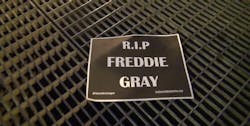In late April, a week of demonstrations and rioting erupted in Baltimore after a 25-year-old black man named Freddie Gray died of a spinal cord injury while in police custody. Anyone who watched even a few minutes of TV coverage probably recalls the burning vehicles and looted CVS pharmacies. Footage of Toya Graham chasing her teenage son off the street while smacking him in the head went viral.
At about the same time, a contractor posted a story to our LinkedIn page about losing another bid to a noncertified window replacement contractor. His bid was 50 percent higher, and he complained that the contractor who got the job told the homeowner that he wouldn’t disturb any paint while replacing the windows. His post concluded with a familiar rant against big government and over-regulation.
I didn’t make the connection until I read an April 29 story in The Washington Post about the extraordinarily high blood lead levels among black children growing up in Baltimore’s Sandtown neighborhood. It was in a rental property there that Freddie Gray was poisoned by lead paint that flaked from the peeling walls and windows.
Evidence from a lawsuit filed by Gray and his siblings against the property owner revealed that a blood test taken when he was just 9 months old showed 10 micrograms of lead per deciliter of blood—that’s double the maximum level set by the Centers for Disease Control and Prevention. Three months later, his blood tested at almost 30 micrograms, and just before his second birthday, it measured 37 micrograms.
Gray’s history reminded me of the RRP (Renovation, Repair and Painting) certification class I took in 2010. Our instructor told a story about when he and his wife had their first child. They were living in public housing just after college because it was all they could afford. They knew that the doors and windows would stick a little, but they didn’t know that each time they opened or closed them small particles of dried lead paint scraped off and floated onto the carpet and bedding and toys.
They soon noticed problems with their son’s balance and reaction time, so much so that he couldn’t put his hands out in time to break his frequent falls. Finally, during a hospital visit to treat bruises on the boy’s face from a bad fall, a blood test revealed that he had lead poisoning.
I’m sympathetic to the plight of small remodelers competing against uncertified, unlicensed, and uninsured contractors who don’t know their costs, have never pulled a permit, and are unaware of or ignore regulations such as the RRP. But I also know that poisoning from lead paint has real-world consequences.
Whatever the undisclosed settlement was in Freddie Gray’s 2008 lead-poisoning lawsuit, it came too late to undo the damage that had already been done. I don’t know whether the problems he had while growing up—trouble in school, drug abuse, repeated run-ins with the police—happened because he was poor or because he was black or because he was poisoned by lead. But the combination seems to have been deadly.
For remodelers, the RRP rule is an expensive hassle, but compliance won’t kill anybody. Noncompliance just might. PR
---

